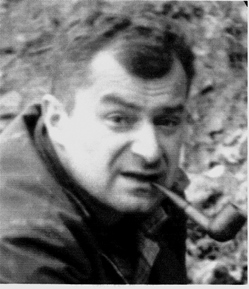 Stanisław Dżułyński, known as Miś, elected Honorary Fellow of the Society in 1965, was born on August 27, 1924, in Sambor near Lvov of then Polish eastern Galicia. He began his education in Lvov but obtained his PhD in geology from the Jagiellonian University in Krakow in 1951. Miś used to say that he left his heart in Lvov. As it happened, he found his life-long intellectual refuge and a stimulating scientific environment in Krakow’s academia. His scientific interests were extremely broad and his intellectual capacities tremendous. He will probably be best remembered outside Poland as one of the heroes of clastic sedimentology at the time of its rapid development in 1960s and 70s.
Stanisław Dżułyński, known as Miś, elected Honorary Fellow of the Society in 1965, was born on August 27, 1924, in Sambor near Lvov of then Polish eastern Galicia. He began his education in Lvov but obtained his PhD in geology from the Jagiellonian University in Krakow in 1951. Miś used to say that he left his heart in Lvov. As it happened, he found his life-long intellectual refuge and a stimulating scientific environment in Krakow’s academia. His scientific interests were extremely broad and his intellectual capacities tremendous. He will probably be best remembered outside Poland as one of the heroes of clastic sedimentology at the time of its rapid development in 1960s and 70s.
Miś Dżułyński established himself as a founder of modern sedimentological studies in the Carpathian flysch basin shortly after returning to Poland from his post-doctoral fellowship at the US Geological Survey in 1959. Dżułyński’s groundbreaking publications on turbidity current-produced sedimentary structures brought him international fame quite early in his career. Applications of turbidity-current theory, which revolutionised our understanding of sedimentary basins, were the subject of his work on the Carpathian flysch basin in southern Poland. This work quickly won international acclaim and became classic due to its worldwide application in basin analysis. His subsequent work on geomorphology and karst as an ore-forming process in Mississippi Valley-type deposits also won international recognition, though flysch hieroglyphs remained his favourite subject until the end. Sadly, Dżułyński’s recent plans to display his astonishing collection of hieroglyphs at the Jagiellonian University might now be abandoned.
Miś Dżułyński’s scientific interpretations and his contribution to geology gained him a reputation as a giant long before model-driven, a priori geoscientific activity began to compete with sound, fieldwork-based geological research. Field observations and flume experiments were, as a rule, the starting point for his carefully verified and clearly presented conclusions. His students were made well aware that without a solid field component, their interpretations and conclusions would never gain the approval of the Master. In that respect, this otherwise very tolerant man was uncompromising. Discipline in gathering observations and logic in drawing conclusions needed to be adhered to strictly. He insisted that the geological models of his students be free of petitio principii.
Miś was a man of an unquestionable scientific quality and extremely high moral standards. He taught his students not only how to solve scientific problems, but also how to live a decent academic life. His direct attitude toward peers and students alike created around him a unique atmosphere of distinction that combined friendship and tutorship. His peers often envied him the admiration and love which young researchers felt toward him. Miś did his utmost to help others in the advancement of their scientific goals. Many owe him much; a few probably even too much. But while he knew this, he believed that undeserved kudos can stimulate while undeservedly harsh criticism often stifles creative endeavour. Miś derived great pedagogical satisfaction from seeing his students surpass his own accomplishments and incisively critique his errors. And while this happened only rarely, it showed just how gracious and intellectually honest he truly was.
Not only was Miś an outstanding scientist and teacher, he was also a great humanist. He understood many languages and was at home in Latin, English, French, German and Serbo-Croatian. He had friends from many countries. Because of his facility with languages, his knowledge of cultures was both broad and profound. Miś admired all that enriched human life. As a scientist, he loved not only people but all living creatures, which he spared no effort to protect until his last days. Miś lived life to the fullest, worked with a rare passion, and knew how to enjoy good food and drink in the company of friends. In fact, he was renowned among friends for the quality of his own cuisine.
By example, Miś demonstrated that it is not the sheer quantity of publications, or the power of sponsors and supporting peers, nor honours and titles that make a scientist great. He deliberately downplayed his own distinguished academic status and never mentioned the many honours bestowed upon him, including an honorary membership of the Geological Society of America. With characteristic wit and modesty, he jokingly referred to his last official honour, a 1996 Honorary Doctorate from Warsaw University, as his Doctorate “Humoris” Causa. He was a profoundly decent man. His scientific acuity, modesty and personal charm will be deeply missed by all who came in contact with him.
Tom Jerzykiewicz